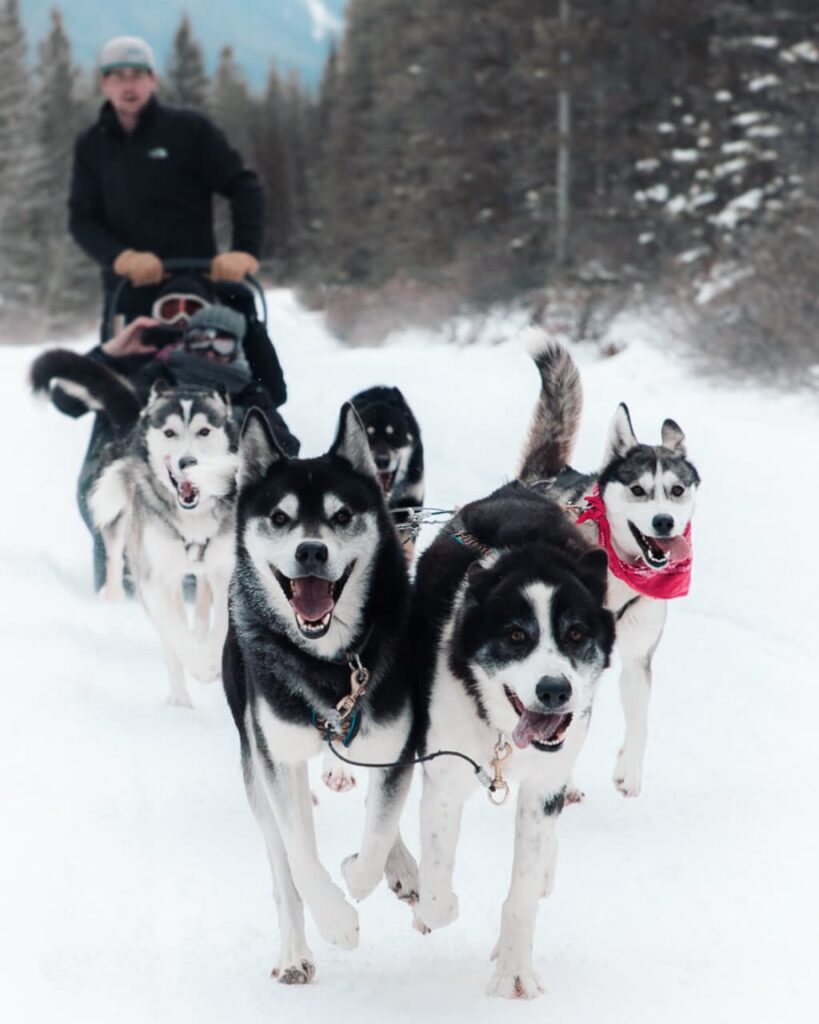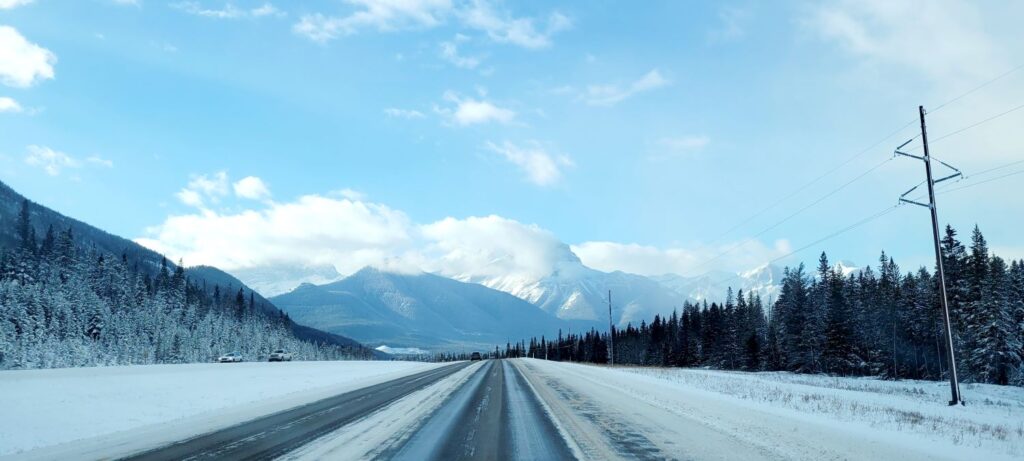Banff National Park is not only famous for its mountains and lakes but also because it is home to some of Canada’s most iconic animals, such as moose, wolves, bears, and cougars.
Although there are no guarantees for spotting wild animals in Banff, knowing the hotspots definitely gives you a better chance of success.
This guide provides some tips on how and where to spot all kinds of wildlife in Banff safely and respectfully, so you can make the most of your visit.
What animals live in Banff National Park?
Let’s start with the animal everyone wants to see from a safe distance, and that is bears.
Are there bears in Banff National Park?
Yes, in fact, the park is home to two species of bears – the grizzly bear and the black bear.
Both typically stay at higher elevations among the trees and are found at lower elevations during the spring and summer due to changes in snow cover.
During the winter, the bears hibernate, but there is still a chance you will see one even in late November, so don’t forget your bear spray!
Spring and early summer are the best times to see bears in the Canadian Rockies.
Grizzly bear

There are only around 65 grizzly bears in the park.
Sadly, these beautiful creatures are considered vulnerable due to habitat destruction and human involvement, mainly through unfortunate road accidents.
PLEASE drive carefully around the park and always be on the lookout, as you never know when an animal will suddently run out in front of you.
They can be seen in all parts of the park, but you are less likely to see this type than you are to see a black bear.
They are solitary animals that tend to frequent areas with a higher concentration of food sources.
Grizzlies are omnivores, meaning they eat plants and animals, including other bears.
The park is home to two well-known grizzly bears, Split Lip (Bear 136) and The Boss (Bear 122).
Split Lip earned his name from a dark scar on his mouth, likely caused by a fight with another bear.
He has been seen around Sunshine Village ski resort and on the Sunshine access road.
The Boss is the largest grizzly in the park, weighing around 650 to 700 pounds (295–317 kg).
He has fathered most of the cubs in the Bow Valley. He’s also been hit by a train and survived.
This legendary bear showed who’s the boss in 2020 when he had a standoff with Split Lip and chased him away.
As well as the Sunshine Village ski area, you might see a grizzly along Highway 742, Icefields Parkway, Mount Assiniboine Provincial Park, and Highwood Pass/Highway 40.
We caught a glimpse of a grizzly while on the Lake Louise gondola. This seems to be where there are numerous sightings.
Black bear
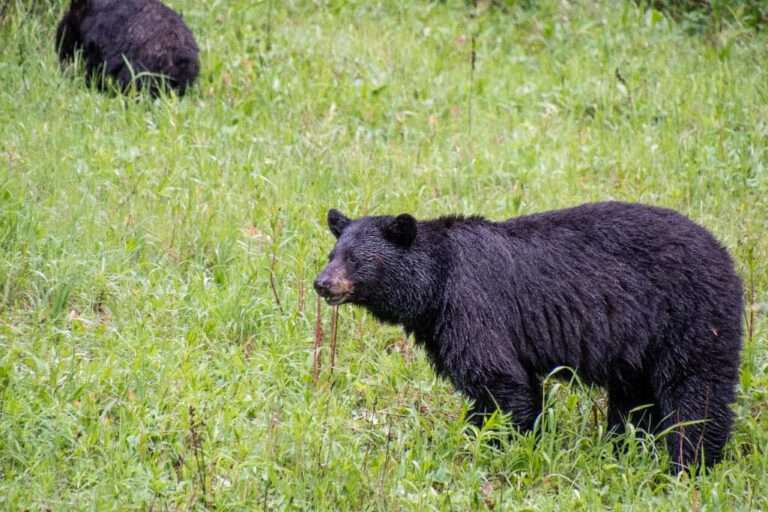
There are between 20 – 40 black bears in Banff National Park. These bears are omnivores, feeding on both plants and animals.
After hibernation, you could see them along the Bow Valley Parkway, which we’ve been lucky enough to see a couple of over the years.
Black bears can also be found in Bow Valley Provincial Park, Icefields Parkway, around campgrounds, and generally throughout the area.
Canmore and Waterton Lakes National Park also have their fair share of bear sightings.
How to tell the difference between a grizzly and a black bear.
It’s easy to tell the difference between a grizzly bear and a black bear.
Grizzlies are known for their distinct, prominent hump between the shoulder blades. The backside of a black bear is higher than the rest of the body.
I remember reading somewhere that the best way to remember the difference between the two is that grizzlies have “raised humps” and black bears have “raised rumps.” If you remember that, then telling them apart should be easy.
They also differ in claw size. Black bears have shorter claws that are just over 1 inch long. A grizzly’s claws can be as long as 4 inches.
Their facial features are different as well. A black bear’s face has a straight slope from the nose to the top of its head, whereas a grizzly’s face is more rounded and concave from the nose to the forehead.
Bison
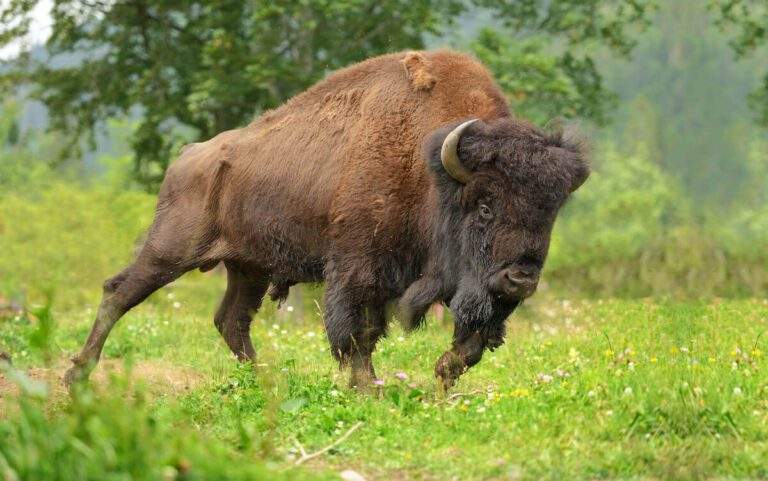
The return of bison to Banff National Park took place in 2018, where they were situated in very remote sections of the park.
The chances of seeing bison are slim at best unless you are an experienced backcountry user, but that may change as their numbers grow.
Moose
The moose is the largest member of the deer family and is about the size of a horse.
They can stand up to 6 feet (1.8 m) tall and weigh over 450 kg (1,000 lbs). They are light to dark brown in color and have huge antlers, which they use against predators.
Sadly their numbers have declined considerably over the last few decades. It’s thought there are only around 65 throughout the park.
If you want to increase your chances of seeing a moose, go early in the morning or late in the afternoon when they come out to graze.
The best spots are near Upper Waterfowl Lake along the Icefields Parkway, Jasper’s Moose Lake Loop, and north of Saskatchewan Crossing.
Elk
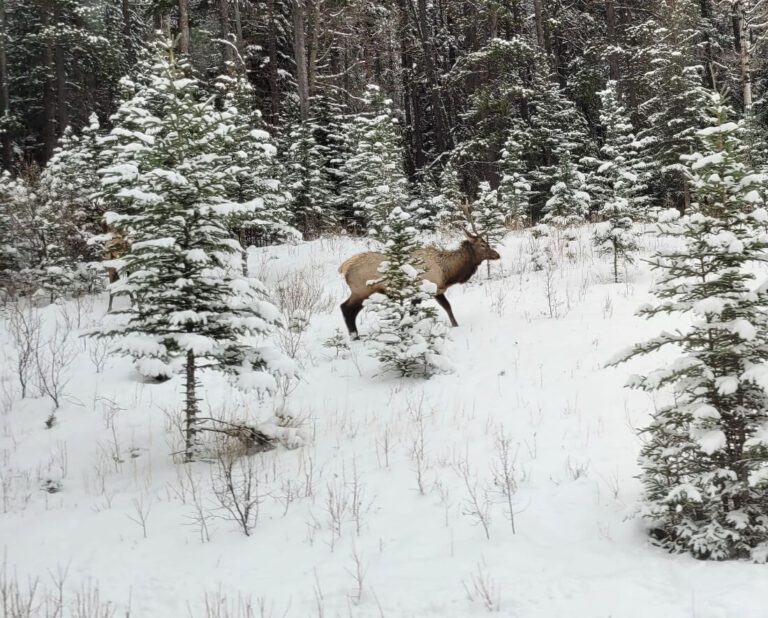
The elk population is in the thousands in Banff NP and they can be seen throughout the park and close to the town.
The best places to see elk are at the Buffalo Paddock, Banff Springs golf course, Vermilion Lake Drive, and the Bow Valley Parkway.
While they might look harmless, they can be dangerous if provoked, which is something you don’t want to do to an animal that big.
It’s important to keep your distance and never approach them, especially during the mating season between September and October.
Banff National Park is home to over 50 mammal species, over 260 species of birds, 19 species of fish, 1 reptile, 4 amphibians, and a staggering 844 plant species.[1]
Bighorn Sheep

You can spot these creatures with their distinctive curved horns throughout Banff National Park, especially along the Bow Valley Parkway and the roads near Lake Minnewanka.
The large rams can be found at lower elevations during the winter and higher up in the alpine meadows during the summer.
Mule Deer + Whitetail Deer
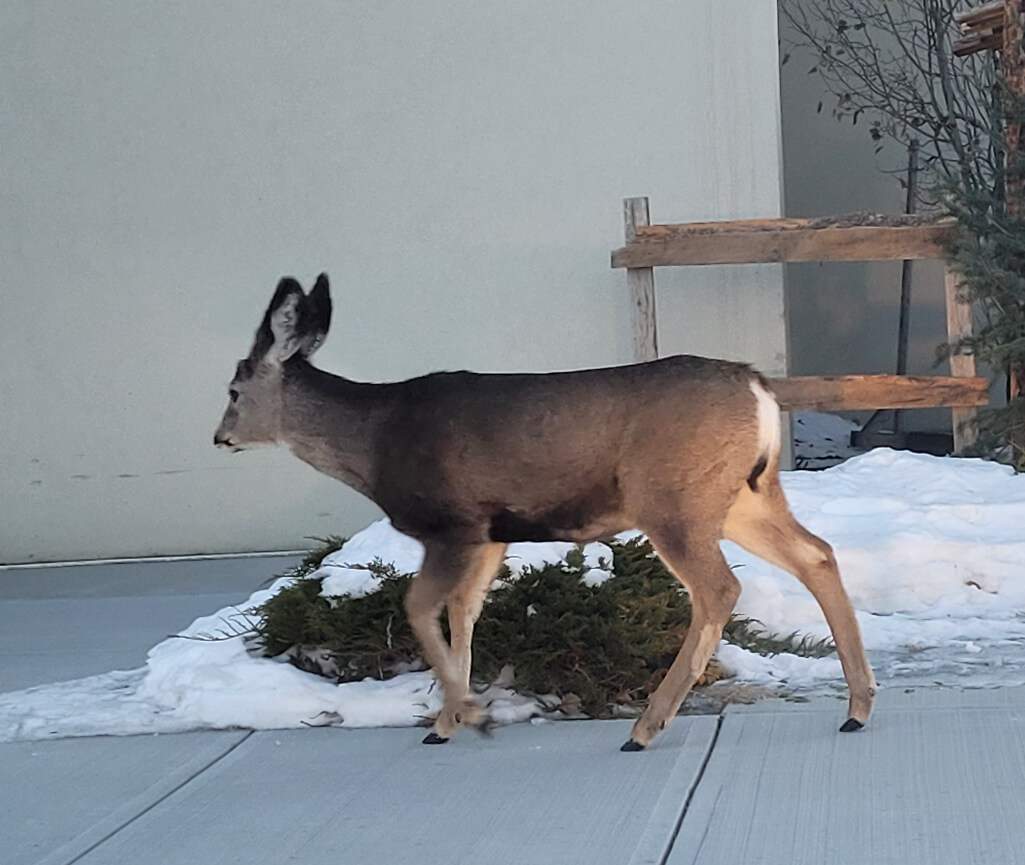
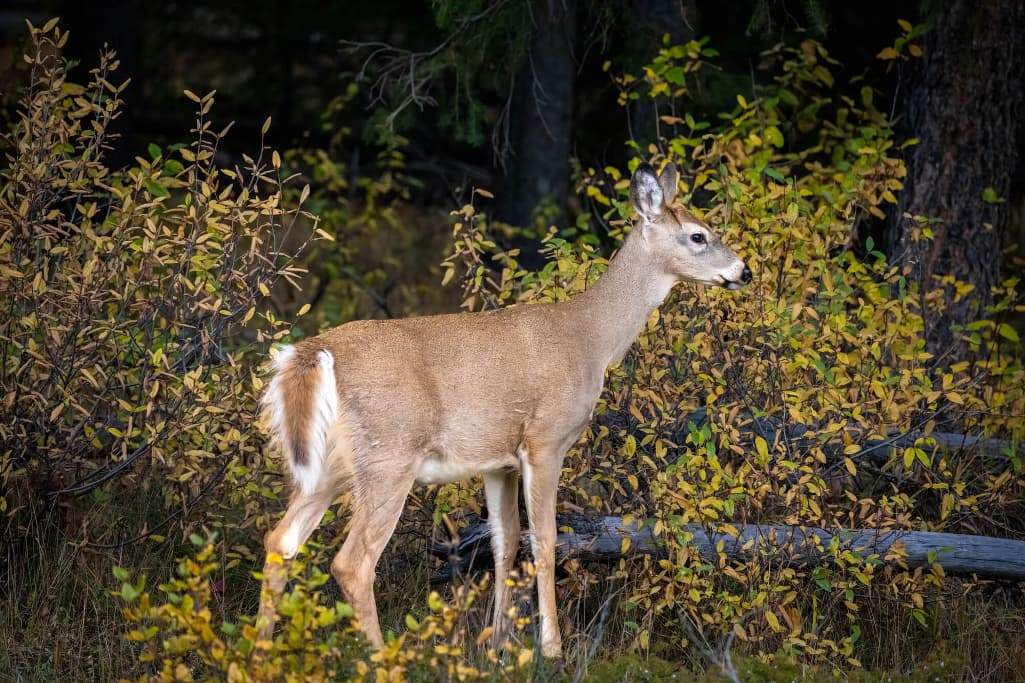
Banff National Park is home to both species of deer. They are usually seen along Vermilion Lakes Drive and the Bow Valley Parkway feeding on vegetation.
Both are similar in size and appearance. In the summer, both have brownish-reddish coats that become gray in winter.
The mule deer is more common and has larger eyes and ears and a narrow white tail with a black tip.
Mountain Goat
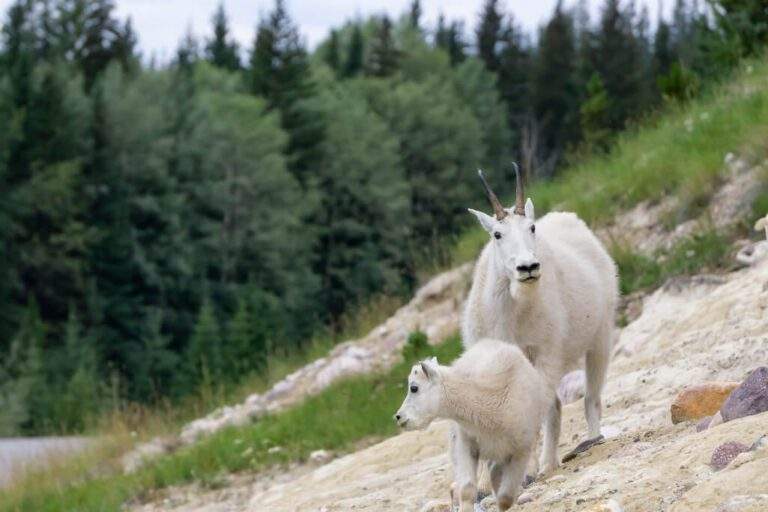
These surefooted creatures can often be seen scaling steep rocky terrain along the Icefields Parkway, towards Jasper National Park, and the more out of the way, Bourgeau Lake.
They have thick white fur, a beard, and black horns.
They live in small herds and feed on plants and other vegetation. In late spring, you might see these animals licking the minerals from roads along the Icefields Parkway which is thought to help restore their coats.
Wolf
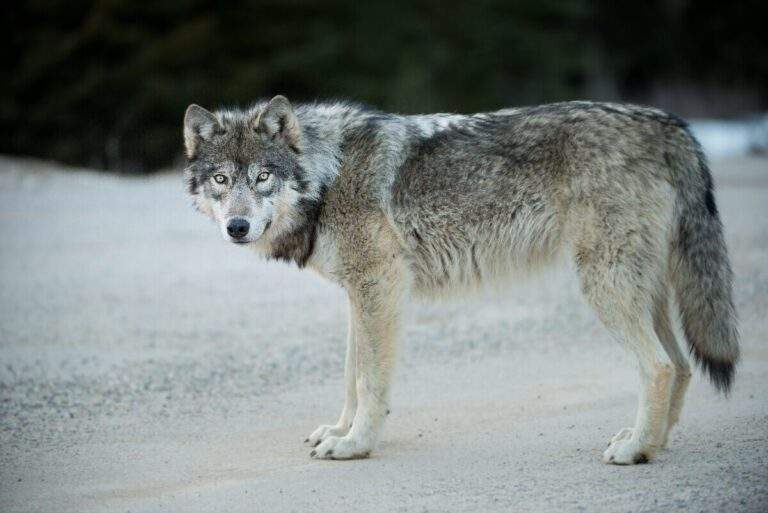
Banff National Park is also home to the beautiful gray wolf.
The color of their coats can range from white to black. The gray wolf is the largest member of the wild dog family, and an adult can weigh as much as 60 kilograms (130 pounds).
After being eradicated from the park in the 1950s, they returned in 1982. It is estimated that there are about 45 wolves now, comprising 5 to 6 different packs.
These predators thrive in the expansive wilderness, where they can find food and shelter.
Wolves live close to where they can access deer, elk, and moose, so as you might have guessed, one of these areas is along the Bow Valley Parkway.
You might be lucky and see wolves in the early morning or late evening hours when they are most active.
Coyote
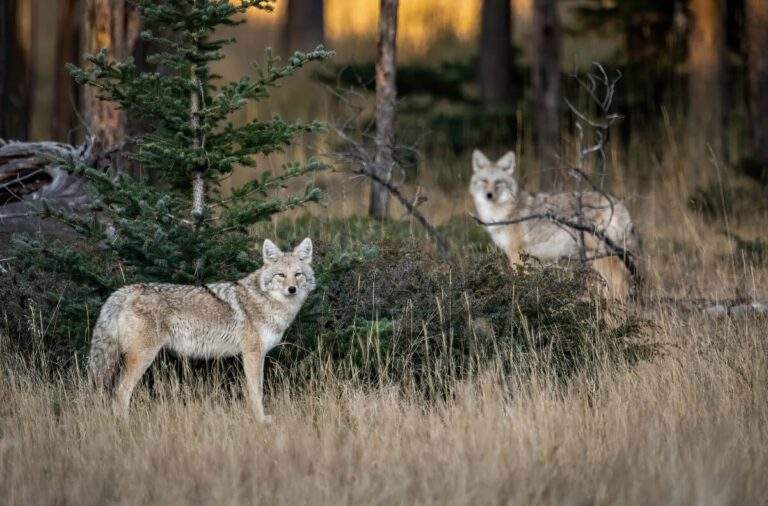
A coyote is smaller than a wolf and similar to a medium-sized dog weighing 9–16 kg (20–35 lbs). Their coat is gray on top, brown on the sides, with a pale underside.
Coyotes don’t travel in packs and are usually seen alone or in twos but get together to hunt larger prey.
Sadly their numbers have also declined in the park over the last few years because of increased road traffic and railway accidents.
These wild dogs are scavengers and feed on roadkill, rodents, and vegetation.
They can be seen throughout the park in open spaces and areas with good hunting grounds, such as the Vermilion Lakes Road, Bow Valley Parkway, and the Buffalo Paddock and out towards Radium on Highway 93 South.
Red Fox

With an easily recognizable fuzzy tail, the red fox is the size of a small dog and weighs around 5 kg (11 lbs).
Despite its name, this small carnivore can be black, silver, brown, or a cross between red and silver.
Although common throughout the National Park, the fox is nocturnal but seen in day-use areas looking for food.
Cougar/Mountain lion/Puma
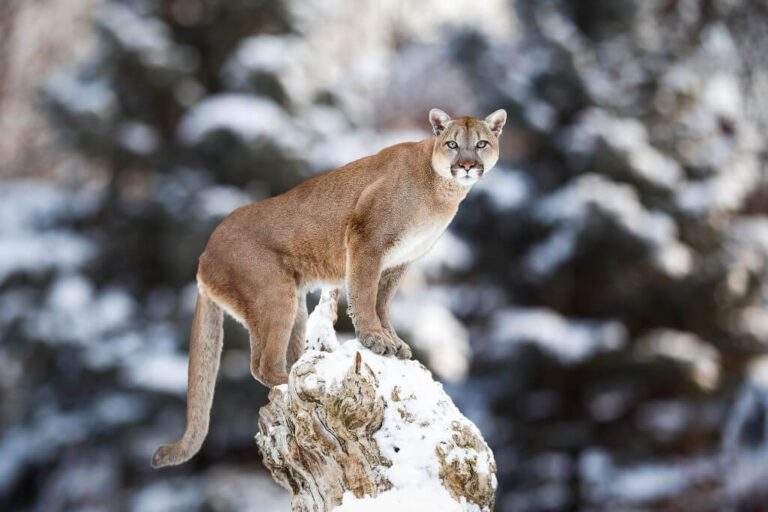
While cougars present a very real danger, it is important to remember that sightings are rare.
Even so, you should take necessary safety precautions and be aware of your surroundings when out on trails, etc.
This wild cat can weigh up to 70 kg (154 lbs) with a 1.5 m long body. It is short-haired with a tawny-colored coat, yellowish belly, and white chin and throat.
Although the chances of coming face to face with one are slim, you will often see signs warning you that a cougar has been reported in the area.
We’ve seen these signs in the Tunnel Mountain area as well as in Canmore.
Canadian lynx
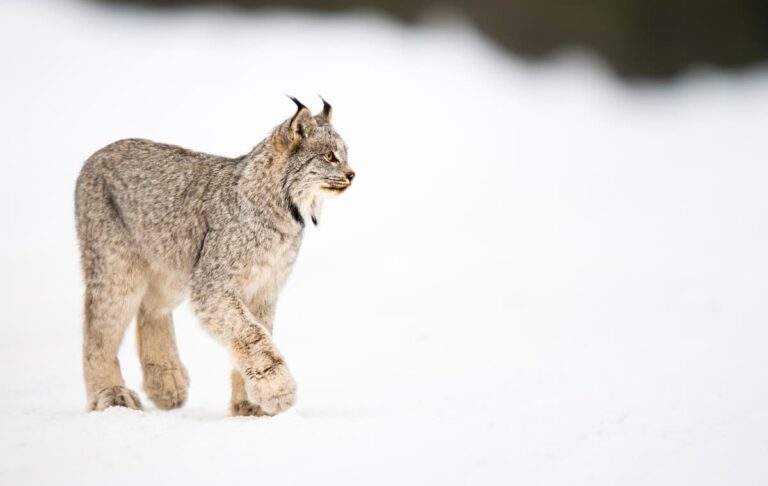
Just like the cougar, seeing a lynx is incredibly rare. This elusive wild cat boasts an impressive coat of thick fur, triangular ears with black tips, and a uniquely wide footprint.
Their back legs are longer than the front legs, so they slope downwards from the back to the head.
They prey mainly on snowshoe hares and live in the rocky uplands with lots of trees.
The lynx is smaller than the cougar, standing between 48–56 cm (19–22 in) tall, and weighs between 5 – 17 kg (11 and 37 lb).
Hoary Marmot

Sometimes referred to as a whistle pig, the park’s largest rodent can weigh up to 4.5 kg (10 lbs).
These furry critters can be found in abundance scurrying around the rocky alpine meadows above the treeline.
When they’re feeling threatened, they will stand up on their hind legs to get a better look at their surroundings and produce an alarm call that sounds similar to a whistle.
When they’re not on the lookout for danger, they can often be seen sunbathing or grazing on grasses.
Pika
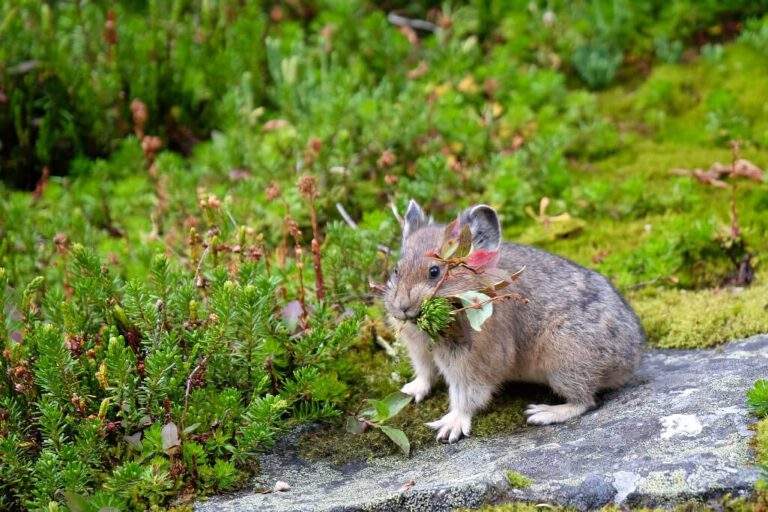
Pikas are small mammals that are part of the rabbit family. They are brown and gray colored with small rounded ears and a rounded body.
Even if you can’t see one, you will no doubt hear its high-pitched “eep”.
These cute little critters are often seen on the rock slides at Moraine Lake and toward the far end of Lake Louise.
Porcupine
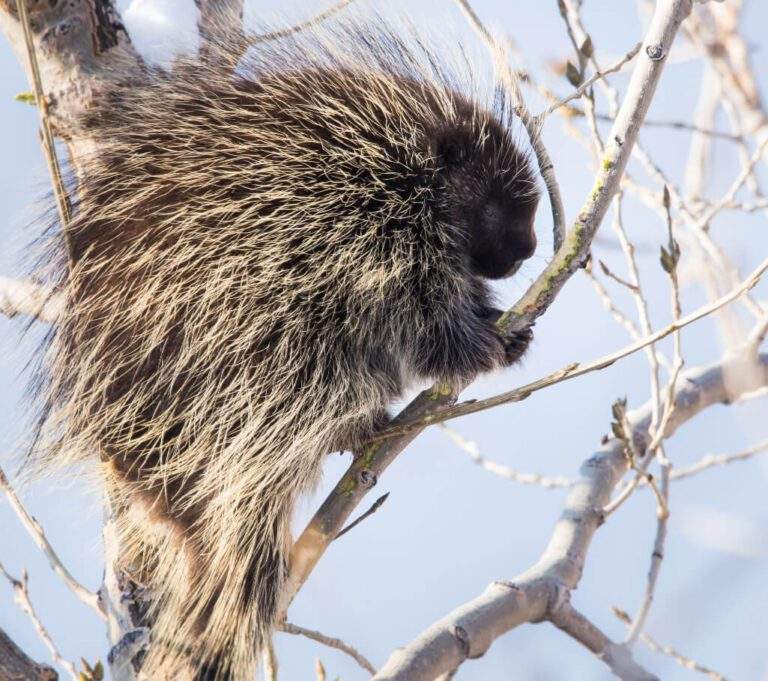
Armed with around 30,000 quills over its body, porcupines are found around Lake Louise, Yoho Valley Road, Paradise Valley, and the Elbow Lake region.
As these animals are nocturnal, it’s unlikely you will come across one, but if you do, it will probably be napping in a tree.
Porcupines like salt, so they snoop around campgrounds at night for hiking equipment to lick the salt off.
Birds
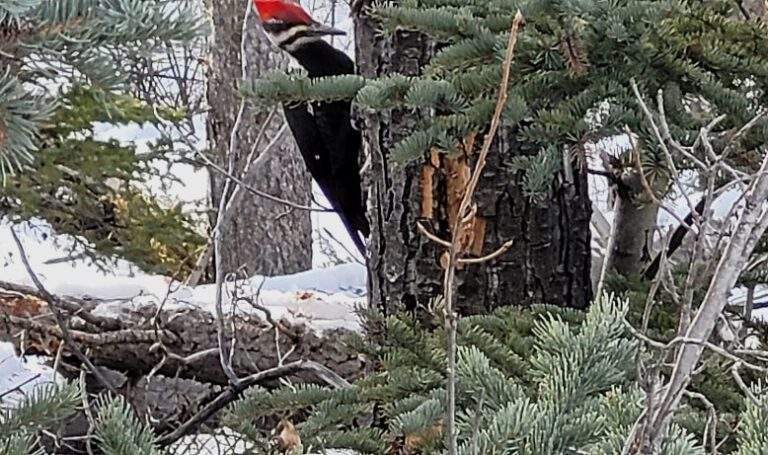
Banff National Park is also home to a variety of birds, with over 260 species recorded, including the majestic bald eagle, several species of owl, woodpeckers (sorry my photo above isn’t better), warblers, osprey, Canada geese, grouse, and the list goes on.
You can grab a checklist of all the birds found from Park Information and Visitor Centres.
It’s important to know the best places to go in the park to get the best wildlife viewing experience. So, let’s move on and explore some of these next.
Best places to spot wildlife in Banff National Park
Where is the most wildlife in Banff? You’ve no doubt seen a pattern here, with the Bow Valley Parkway and Icefields Parkway being two of the best places to view wildlife.
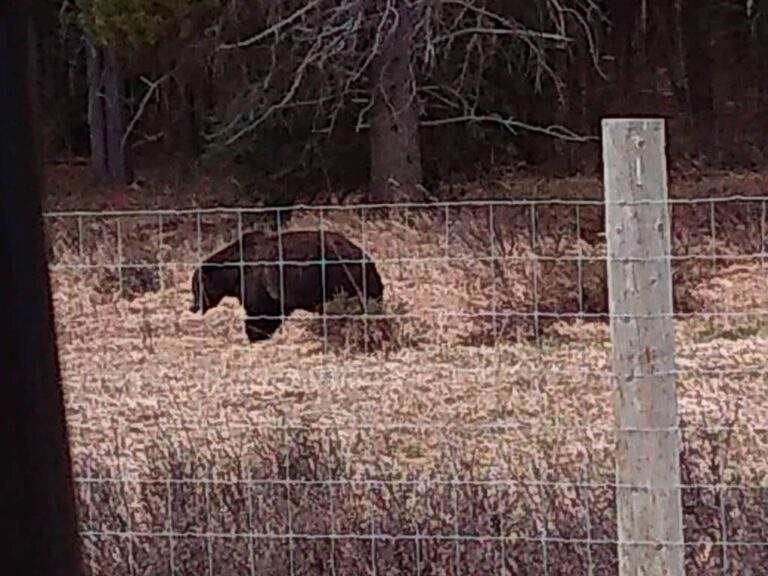
The Bow Valley Parkway is a scenic drive from Banff to Lake Louise, and you’ll want to take this route instead of the Trans-Canada Highway when you want to spot the animals.
Drive from Lake Louise to Jasper along the Icefields Parkway, which is one of the most beautiful drives in the world.
This route is full of wildlife, with elk, deer, bighorn sheep, mountain goats, grizzly bears, black bears, wolves, and coyotes all living in the area.
Other places to view wildlife include the Vermilion Lakes, the Lake Minnewanka Loop, and the Sulphur Mountain area.
Outside Banff is Spray Lakes Road, located near Canmore, up past the Nordic Centre.
This takes you through some of the most beautiful parts of the Rocky Mountains. Along the way, you might spot various wildlife such as bears, bighorn sheep, lynx, snowshoe hare, moose, and coyote.
These are just a few great places to view wildlife in Banff National Park.
Respecting the wildlife
Visiting Banff National Park is a great way to experience the beauty and magnificence of its natural wildlife.
As you explore the area, you may come across various animals, and it’s an exciting experience, but it’s important to remember that wildlife must be respected.
Here are a few important things to keep in mind:
- Keep your distance: Wild animals are unpredictable and can become dangerous if they feel threatened. It’s vital to maintain a safe distance from any animal you encounter.
- Be aware of your surroundings: Wild animals may be hidden, so it’s important to be aware of your surroundings and watch for signs of animals.
- Don’t feed the animals: Feeding wild animals can be harmful to their health and disrupt their natural behavior. It can also make them more aggressive toward humans.
- Stay in your car: If you come across a wild animal, stay in your car and observe from a safe distance. It’s common sense that you don’t get out and try and get close to it to take a photo, but you’d be surprised at how many people actually do this!
Full guidelines can be found on the Parks Canada site.
Wildlife tours
Another way to explore the park and see these animals is to go on a guided tour where you can also learn more about the history of the park, the different species that live there, and the park’s conservation efforts.
Several companies offer these tours, including Banff Adventures, and Discover Banff Tours.
Visiting a sanctuary is something else to consider. Yamnuska Wolfdog Sanctuary is a not-for-profit organization that provides a safe place for wolfdogs to live.
You can book either through their website or through one of the tour companies.
Either way, I highly recommend it as it supports such a great cause. You can also read more about it on my winter activities in Banff page.
If you want to see a bear, you’re guaranteed to see one at the Grizzly Bear Refuge. Again, you can book via their website or as part of a tour.
Wildlife of Banff
By now, you know Banff National Park is a haven for wildlife, making it one of the most popular and exciting destinations for nature lovers. Even if luck isn’t on your side and you don’t spot any animals, there’s always something special to appreciate in the park.
Thank you for reading.

